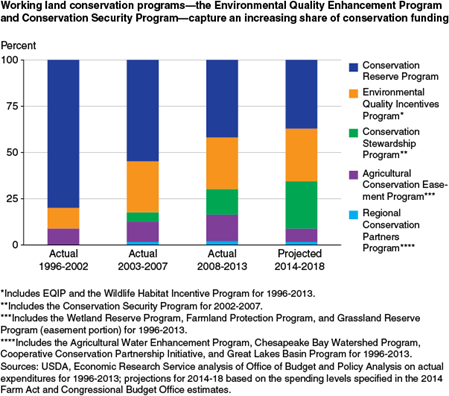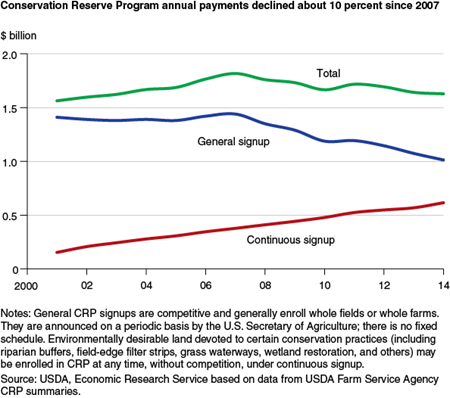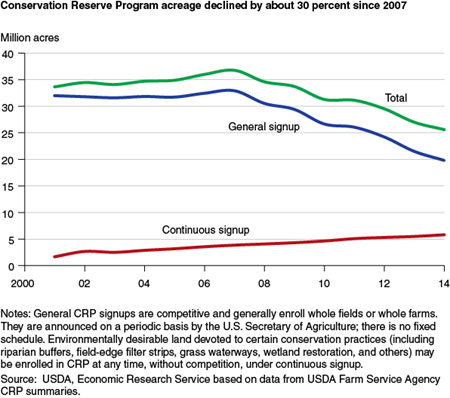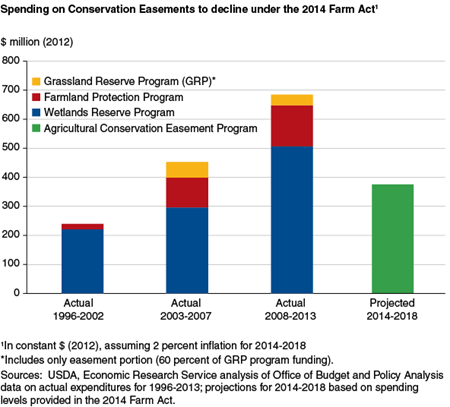2014 Farm Act Continues Most Previous Trends In Conservation
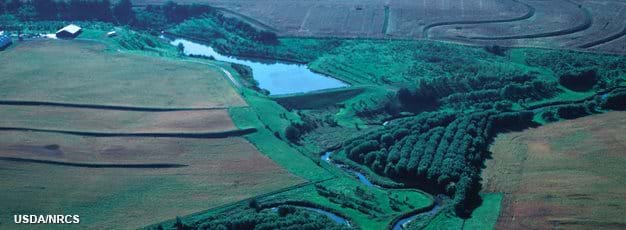
Highlights:
-
The Agricultural Act of 2014 continues a strong overall commitment to conservation, with an emphasis on working land conservation.
-
Many conservation programs are consolidated into new programs or merged into existing programs, reducing the number of USDA conservation programs from 23 to 13.
-
Crop insurance premium subsidies are re-linked to Conservation Compliance (conservation of highly erodible land and wetlands) for the first time since 1996.
The Agricultural Act of 2014, also known as the 2014 Farm Act or Farm Bill, continues a strong overall commitment to conservation. However, unlike the previous two Farm Acts passed by Congress in 2002 and 2008, the 2014 Farm Act does not include an increase in overall funding for conservation programs. Between 2014 and 2018, the Congressional Budget Office (CBO) estimates mandatory conservation spending of $28 billion, about $200 million less than CBO’s projection of 2014-18 spending if the programs and provisions of the 2008 Farm Act had been extended. Although most conservation programs receive “mandatory” funding (funding that is required by law and does not require an annual appropriation), the funding levels are not guaranteed and could be revised in future years.
The 2014 Farm Act reduces the number of conservation programs from 23 to 13. Many smaller, more specialized programs were combined to form new programs, folded into existing programs, or simply repealed. Consolidation may create opportunities for better coordination of conservation efforts across the broad range of activities that USDA conservation programs seek to support. Savings in program administration and streamlined application processes may also be realized.
After program consolidations, 97 percent of conservation funding mandated in the 2014 Farm Act will go to the five largest programs: the Conservation Reserve Program (CRP), Environmental Quality Incentives Program (EQIP), Conservation Stewardship Program (CSP), Agricultural Conservation Easement Program (ACEP), and Regional Conservation Partnership Program (RCPP). Conservation Technical Assistance (CTA) is the only large conservation program that is funded through annual appropriations. For 2008-2013, average CTA funding was $737 million per year. Within the five largest programs, the 2014 Farm Act continues the trend of recent Farm Acts toward increasing the share of conservation funding devoted to working land programs (programs that support conservation on land in agricultural production) while reducing the share of funding for land retirement. However, in a departure from recent trends, funding for conservation easements, particularly wetland easement, will decline.
The new Farm Act also helps maintain strong incentives for soil conservation on highly erodible land and wetland conservation by adding crop insurance premium subsidies to the list of benefits that could be withheld from producers who fail to meet conservation compliance requirements. The 2014 Farm Act also creates a new “Sodsaver” provision (crop production on native sod) to help protect grasslands in the Northern Plains by sharply reducing crop insurance subsidies and other limitations on crop insurance (lower transitional yields, for example) during the first 4 years of crop production.
Funding Continues To Shift Toward Working Land
The 2014 Act continues a decade-long trend toward increased funding for conservation on working agricultural land. EQIP and CSP support the adoption of conservation practices or activities on land used for crop production and grazing. CSP can also provide payments that reward farmers who have already demonstrated stewardship by using conservation practices on their farms. Combined funding for these programs is projected to account for more than 50 percent of mandatory spending on major conservation programs during 2014-2018. These programs and their predecessors accounted for just over 40 percent of spending during 2008-2013 and 32 percent during 2003-2007.
Working land programs can fund a wide range of practices including conservation tillage, nutrient management, field-edge buffers, and many more. In EQIP, 60 percent of funds are reserved for livestock- related practices including manure handling systems, fencing livestock out of streams, and rotational grazing, to name a few. Under the 2014 Farm Act, at least 5 percent of EQIP funds are also reserved for wildlife habitat-related practices to incorporate functions of the Wildlife Habitat Incentives Program, which was repealed by the 2014 Act. The minimum stewardship requirement for CSP eligibility is increased in the 2014 Act from having addressed one priority resource concern at the time of program entry (under the 2008 Farm Act) to having addressed two resource concerns. Resource concerns include soil quality, water quality, air quality, and others. To address water quality, for example, producers may be required to reduce the runoff or leaching of sediment, nutrients, pesticides or other pollutants from their farms using a range of conservation practices that could include conservation tillage, nutrient management, field-edge filter strips and others.
The trend toward greater funding for working land programs recognizes that agri-environmental problems cannot be addressed entirely through land retirement. Land retirement programs, even at peak acreage, included roughly 10 percent of U.S. cropland. Soil erosion, nutrient and pesticide runoff, and other resource concerns require a broader approach involving a larger share of agricultural land. USDA data shows that by the end of 2013, more than 280 million acres of agricultural land (including grazing land and other non-cropland) had been enrolled in a USDA working land program at some time. Policy-makers also recognized that conservation practices on working land could often address these issues at a lower cost when compared to land retirement.
CRP Acreage Declining More Than Payments
The 2014 Farm Act reduces the CRP acreage cap by 25 percent from the previous 32-million-acre enrollment cap to 24 million acres by 2017. However, rather than driving program change, the lower acreage limit largely reflects the ongoing decline in CRP acreage. Since 2007, CRP acreage has declined steadily from more than 36 million acres to less than 26 million acres at the end of 2013—a drop of about 30 percent.
However, payments per acre have risen 16 percent in real terms over the same period, so that inflation-adjusted program expenditures have fallen by only about 10 percent. Since 2007, CRP has increasingly focused on high-priority practices (e.g., riparian buffers, field-edge filter strips, wetland restoration) and on State-Federal partnerships (though the Conservation Reserve Enhancement Program) that concentrate on specific problems such as improving water quality in a specific lake or river corridor. These “continuous signup” enrollments are believed to provide a higher level of environmental benefit per acre when compared to the whole field or whole farm (general signup) enrollments that still account for more than 75 percent of CRP acres.
While enrollments under the continuous signup portion of the program accounted for only 23 percent of CRP acreage at the end of 2013, they commanded 38 percent of CRP annual payments. (Annual payments have made up 85-90 percent of CRP expenditures in recent years.) On average, continuous signup practices require less land (an average of 13.4 acres per contract versus 73.9 acres for general signup contracts) and tend to be more expensive per acre ($103 per acre versus $50 per acre for general signup contracts).
In recent years, CRP rental rates have also been adjusted upward to account for higher cropland rental rates, making newly enrolled land more expensive. Average rental rates for general signup enrollments increased from $48 per acre at the end of fiscal year 2011 to $50 per acre at the end of fiscal year 2013.
The 2014 Farm Act also includes authority for enrollment of up to 2 million acres of grassland. The new acres will be enrolled under rules that allow routine grazing, haying, seed harvest, fire suppression, and other grazing-related activities, so long as participants accept a reduction in annual payments commensurate with the economic value of the activity. These contracts would help preserve grasslands, taking up some of functions of the Grassland Reserve Program, which was repealed in the 2014 Act.
Wetland Easement Spending to Decline
Funding for wetland easements was increased in both the 2002 and 2008 Farm Acts, but will decline under the 2014 Farm Act. Since 1992, the Wetland Reserve Program (WRP) and CRP have been USDA’s primary channels for supporting wetland restoration on agricultural land. To date, WRP funding has supported wetland restoration on 2.3 million acres, 80 percent of which are under permanent easement against development for agricultural or other purposes. At the end of 2013, the CRP included just over 2 million acres of wetland, which are protected for the 10-15 year life of the CRP contract rather than the permanent protection often provided by WRP.
The new Farm Act combines the WRP with the Farmland Protection and Grassland Reserve Programs to create the Agricultural Conservation Easement Program (ACEP). The Farmland Protection Program provided funding to State programs that purchased permanent easements against the development of farmland (often called purchase of development right programs). The Grassland Reserve Program offered a range of contracts and easements of various lengths designed to improve grassland and protect it against conversion to other uses. Under the 2008 Farm Act (2008-2012), these three programs received annual funding, on average, of more than $710 million (in 2012 dollars), but the consolidated program is slated to receive only $375 million per year under the 2014 Farm Act (in 2012 dollars, assuming 2 percent inflation for 2014-18). WRP was the largest of the three programs with average annual funding of just over $500 million for 2008-2013—ensuring a substantial cut in funding for wetland protection, even in the unlikely event that ACEP funds are spent entirely on wetland easements.
USDA conservation programs will also continue to support wetland restoration through CRP and other authorities. However, given the shrinking size of the CRP program, the new mandate to enroll grassland, and CRP’s increasing focus on high-priority practices (including wetland restoration) it is not clear whether CRP wetland acreage will increase or decrease over the life of the 2014 Farm Act. Even if CRP wetland acreage does increase, wetlands enrolled in CRP are not permanently protected through perpetual easement as they are under a large majority of WRP contracts.
Focusing Conservation Effort
The new Regional Conservation Partnership Program (RCPP) is designed to leverage conservation funding from other government or non-government sources while focusing conservation efforts on local, State, or regional resource conservation or environmental problems. The new program replaces four repealed programs designed to address multistate regional problems: the Agricultural Water Enhancement Program, the Chesapeake Bay Watershed Program, the Cooperative Conservation Partnership Program, and the Great Lakes Basin Program.
Conservation partners could be State or local governments or non-governmental groups including farm organizations and conservation districts. Groups would propose conservation objectives, the geographic area to be covered, and practices to be supported, as well as provide a significant portion of overall funding. Projects would be selected by the U.S. Secretary of Agriculture from proposals offered by potential partner groups, with high priority given to proposals that include multistate areas; help producers avoid regulation; include a high proportion of producers in the covered area; significantly leverage non-Federal financial and technical resources; address regional, State, or national conservation priorities; and use innovative conservation methods including outcome-based performance measures.
For 2014-18, RCPP will receive $100 million per year plus 7 percent of funding (or acres) for the EQIP, CSP, ACEP, and Healthy Forest Reserve Program, which will be directed through RCPP partnerships. Assistance is delivered to participants through these covered programs.
Conservation Compliance To Remain Strong
The 2014 Farm Act links crop insurance premium subsidies to environmental compliance requirements for the first time since 1996. Farmers who grow annual crops on highly erodible land must apply a USDA-approved soil conservation system or risk loss of a wide range of agricultural payments. Farmers who drain wetlands to make them ready for crop production also risk losing Federal farm payments.
Environmental compliance requirements were enacted as part of the 1985 Farm Act. While the prohibition against draining wetlands was effective immediately, farmers had a period of 10 years—until 1995—to devise and begin applying soil conservation plans on highly erodible cropland that was already in production in 1985. Between 1982 and 1997, USDA data shows that soil erosion on U.S. cropland was reduced by more than one-third, a decline of roughly 1.2 billion tons per year. ERS research has shown that actions taken in response to highly erodible land conservation ( HELC) could account for up to 25 percent of soil erosion reduction.
Relinking crop insurance to compliance for the first time since 1996 recognizes the increasing importance of crop insurance in U.S. farm policy. In recent years, the value of crop insurance premium subsidies has risen sharply as the premium subsidy rate, crop insurance participation rates, and commodity prices have risen. On average, the Federal Government pays roughly 60 percent of crop insurance premiums, and about 80 percent of corn, wheat, soybean, and cotton acres are now covered by some form of federally subsidized crop insurance. In 2012, crop insurance premium subsidies were $6.7 billion, about 60 percent as large as farm commodity, conservation, and disaster assistance payments combined.
Most farmers who have been purchasing crop insurance are already subject to environmental compliance requirements based on participation in commodity, conservation, disaster assistance, or other programs. ERS research has shown that only about 2.4 percent of farmers purchased crop insurance in 2010 but did not receive commodity or conservation payments that would have made them subject to environmental compliance requirements. Extending compliance sanctions to include crop insurance premium subsidies may mean that some of these farms will become subject to compliance for the first time under the 2014 Farm Act. While ERS estimates show that these farms include 4.3 percent of cropland, only highly erodible land or wetland on these farms would be affected by adding crop insurance premium subsidies to the list of programs covered by conservation compliance requirements.
Farmers who would be subject to HELC for the first time because of crop insurance premium subsidies will have 5 years to devise and implement an approved conservation plan. These farmers will also receive high priority for USDA technical assistance in developing and implementing conservation plans. Under wetland conservation, producers who drained wetlands prior to enactment of the 2014 Farm Act will not be subject to loss of crop insurance premium subsidies. Only wetlands drained after enactment can trigger loss of these subsidies.
Farmers who till native sod for crop production in Minnesota, Iowa, North Dakota, South Dakota, Montana, and Nebraska risk losing a large share of crop insurance premium subsidies and will face other limitations on crop insurance and non-insured crop disaster assistance during the first 4 years of crop production. Some limitations would also apply to non-insured crop disaster assistance for crops not covered by the Federal crop insurance program. Native grasslands provide important breeding habitat for migratory birds, especially ducks; once lost, these benefits are difficult to restore. However, ERS research has shown that crop insurance has only a modest impact on grassland to cropland conversion.
Conclusion
The Agricultural Act of 2014 continues a strong emphasis on conservation developed during the past 30 years over the course of six major Farm Acts. While conservation funding has begun to level off after significant increases in the 2002 and 2008 Farm Acts, the new legislation continues funding for working land conservation programs. Land retirement and easement programs, however, will shrink in terms of both acreage and funding. In CRP, an ongoing shift toward high-priority practices that require less land may limit the loss of environmental benefits. Adding crop insurance premium subsidies to the list of benefits that could be withheld under environmental compliance requirements will help maintain incentives for soil and wetland conservation.
The 2002 Farm Act: Provisions and Implications for Commodity Markets, by Paul Westcott, Edwin Young, and Michael Price, USDA, Economic Research Service, November 2002
Emphasis Shifts in U.S. Conservation Policy (Updated), by Roger Claassen, USDA, Economic Research Service, May 2007
The Future of Environmental Compliance Incentives in U.S. Agriculture, by Roger Claassen, USDA, Economic Research Service, March 2012
The Influence of Rising Commodity Prices on the Conservation Reserve Program, by Daniel Hellerstein and Scott Malcolm, USDA, Economic Research Service, February 2011
Environmental Compliance in U.S. Agricultural Policy: Past Performance and Future Potential, by Roger Claassen, Vince Breneman, Shawn Bucholtz, Andrea Cattaneo, Robert Johansson, and Mitch Morehart, USDA, Economic Research Service, May 2004
Grassland to Cropland Conversion in the Northern Plains: The Role of Crop Insurance, Commodity, and Disaster Programs, by Roger Claassen, Fernando Carriazo, Joseph Cooper, Daniel Hellerstein, and Kohei Ueda, USDA, Economic Research Service, June 2011



